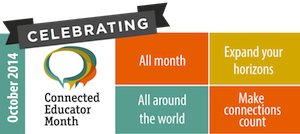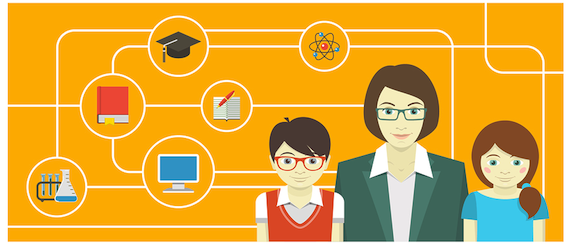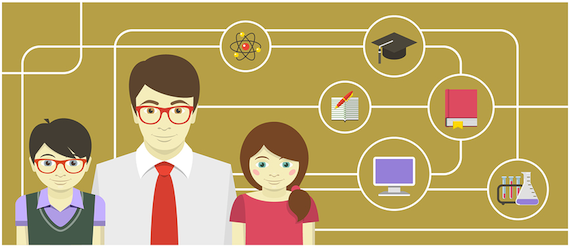Common Core Needs Connected Educators
A MiddleWeb Blog
 Well, it’s October. And I certainly cannot let the month go by without sharing some of my musings on Connected Educator Month. If playing a quick word association game (I just love to throw in a little psychological fun into my educational journey!) what do you automatically think about when you hear, “connected educator?”
Well, it’s October. And I certainly cannot let the month go by without sharing some of my musings on Connected Educator Month. If playing a quick word association game (I just love to throw in a little psychological fun into my educational journey!) what do you automatically think about when you hear, “connected educator?”
Please feel free to add your immediate associations in the comment section below. Do not give it a lot of thought—it should be an automatic, spontaneous reaction to the question, what is the first word, phrase, or idea that comes to mind when you think about what it means to be a connected educator?
I quickly remember back to my post from last October, Connected Co-Teachers Rule! It is natural to automatically associate the term connected educator with a life long learner who connects with other educators through online professional learning communities.
My quick musings would look something like this:

It’s exhilarating, it’s rejuvenating, it’s validating, it’s mind-blowing—simply put… being a connected educator means powerful learning and collaboration that is boundless, it is ceaseless, and it is vigorous. It is the oxygen for educators who strive to be contagious learners. Connected educators provide learning links so their students have multiple opportunities to learn in personal and meaningful ways.
A larger vision of connectedness
I just returned from a four-day Network Training Institute where I collaborated with instructional coaches, teachers, and administrators from around my state. We spent time analyzing the English and math Common Core Curriculum within the realistic context of what’s actually happening in our schools.
We listened to presenters who shared their knowledge, expertise, and experiences around how to effectively implement high standards, so that all students will have the opportunities to connect to a meaningful learning process. The entire experience was an active, hands-on way to internalize the rigorous learning process that we are asking our students to be a part of. It was invigorating.
And it made me think…
Connected educators are those educators who remain solidly on their own learning paths so they inspire students to become connected learners in their classroom. These educators continue to learn behind the scenes of class time through online communities, face to face PD, and personal professional readings and/or writings.
In addition, they remain learners during class time. They apply instructional processes (such as project based learning) that allow students to take charge of their learning. These educators stay connected to their students’ perspective, and then they jump into the process of learning by listening to what their students have to say. They allow their students to feel the learning—not just receive it.
These educators are true learners themselves—and it is contagious. And their students catch the buzz. These educators create classrooms filled with connected learners who:
1. Connect their attention and are ready to listen and apply action to meet learning goals.
2. Connect personal meaning during the academic process.
3. Connect the known with the new—they activate their prior experiences to deepen their understanding of new learning.
4. Connect to the desire to reach far and wide to learn more, to be more, to collaborate more, and to experience more.
Connecting is about broadening knowledge
At the most basic level, in order for learners (any learner) to be successful, they must activate their background knowledge to connect prior knowledge to new knowledge. Learners must be aware of their thinking so they can question, visualize, analyze, synthesize, and create. Check out how to create metacognitive thinking here.
Connected educators are connected learners who motivate students to join in on passionate learning journeys. And through these learning experiences, learners build upon their knowledge base—and begin to create broad knowledge to guide and deepen their learning.
Ken Wagner, the Deputy Commissioner for Curriculum, Assessment, and Educational Technology at the New York State Education Department, kicked off one of our conference days in a huge way. He reminded us that educators must make time for “personal and professional curiosities in the process of building our own broad knowledge base.”
He continued to share: “Broad knowledge of the world helps us to understand what makes others hum—it helps us to do our jobs better.”
And that’s what connected educators do. They commit to an endless cycle of learning. They build upon their knowledge base for content areas and they build upon their knowledge of how their students learn. And they never cease to be amazed at the power of connecting with colleagues, with professional websites and journals, and with their students to deepen their understanding of the world. And this learning is contagious.
We’re on a passionate mission
Connected educators are constantly on a mission to provide deep, powerful learning for their students through multiple means of accessing the rich content of the Common Core. We, the connected educators, must be passionate learners who plan intentionally for meaningful learning to happen within our instructional time.
“Broad knowledge,” Wagner said, “is about making connections after connections after connections—lighting up the whole brain—light after light after light.” That just screams Universal Design for Learning (UDL)! And if you’ve read any of my prior posts, you know how I feel about that! Check out this post, or this post, and/or even this post, to see some of my thinking on using UDL as the perfect bridge to connecting learners to their personal learning process through the Common Core.
Creating connected learners
Common Core provides a true pathway to create connected learners. Yes, I said it. And here’s why (another simple, but powerful phrase spoken by Ken Wagner at this conference): “Common Core is a deeper way to connect with topics—it’s not a new way—it’s a deeper way!”
OK, I added the enthusiastic exclamation point—but wow! Can you blame me? That’s a quote that sums it all up in my mind. In fact, this resonated with me so much, I live-tweeted it!
We as Connected Educators and connected learners must create the learning bridges to help our students link their strengths and areas of need to the intentional scaffolds we provide through the instructional process.
We must scaffold just enough to set the stage and to satisfy their right to have access to deeper learning—not the rote, mechanical learning of just memorizing facts. Everything we do, we must do with the foresight of creating expert learners.
We want to motivate learners to feel the process of learning that will make them connected learners in our classrooms, in any classroom, and well into their adult learning years.
What are you doing to remain a connected educator and learner? How are you making time to build your personal and professional curiosities? Is your passion for learning contagious to your students? How do you know? Share your story here!







































When I initially read “connected educator” I thought about being connected to the students. But your further dive into what it really means is inspiring and overwhelming. Thank you for a wonderful post.
Please connect with me on instructomania.blogspot.com.
Hi, Tony, Thanks for sharing your thoughts! Educators have such a rewarding, humbling, and awe-inspiring journey. It can be overwhelming–and yet as we collaborate–we find we become more inspired than ever! I’d love to hear more about what inspired and overwhelmed you as you connected to my post.
Many thanks–all the best!